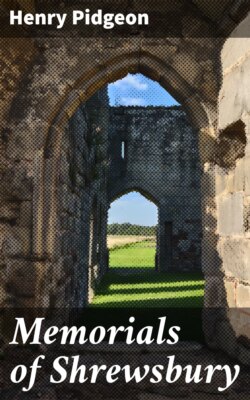Читать книгу Memorials of Shrewsbury - Henry Pidgeon - Страница 8
На сайте Литреса книга снята с продажи.
THE CASTLE.
ОглавлениеTable of Contents
“But time * * *
Has seen this ruin’d pile complete,
Big with the vanity of state.”
Dyer.
The civil history of the town being somewhat connected with the Castle, a notice of that edifice will properly occupy this place.
After the Earldom of Shrewsbury had been given by William the Conqueror to Roger de Montgomery, one of his first works was the building of a stately Castle, or, rather, the enlargement of a previous one, which it is certain existed here anterior to the Norman Conquest, on that narrow isthmus where the town is undefended by the river.
This is supposed to have taken place about the year 1070, on a site previously occupied by fifty-one houses, and was a measure of necessity, in order to restrain the hostile incursions of the Welsh, to which the town, from its situation near the borders, was frequently exposed; and having probably received injury from the siege two years previous, and being also limited in size, was inadequate to the dignity of a wealthy earl, who enjoyed the feudal supremacy of nearly the whole of Shropshire.
The Castle, in succession, was possessed by the two sons of the founder, until the reign of Henry I. when it became a royal fortress, under the custody of a constable.
Edward I. introduced a new style of castellated architecture; the stronger portion, therefore, now remaining was probably erected by direction of that monarch, being in the style generally adopted during his reign.
On the union of Wales it was no longer important as a place of defence, and the building began gradually to decay, although in the civil war it was repaired and garrisoned for the king, and afterwards escaped the almost general demolition of royal fortresses by its surrender to the parliamentary army in 1645.
The Castle subsequently reverted to the burgesses, who resigned it to Charles II. and that monarch presented it to Lord Newport. It is now the property of the Duke of Cleveland, and is occupied by J. C. Pelham, Esq. one of the members for the borough.
The present remains have a picturesque effect, and are composed of a deep red stone. They consist of the keep, the walls of the inner court, and the great semi-circular arch of
